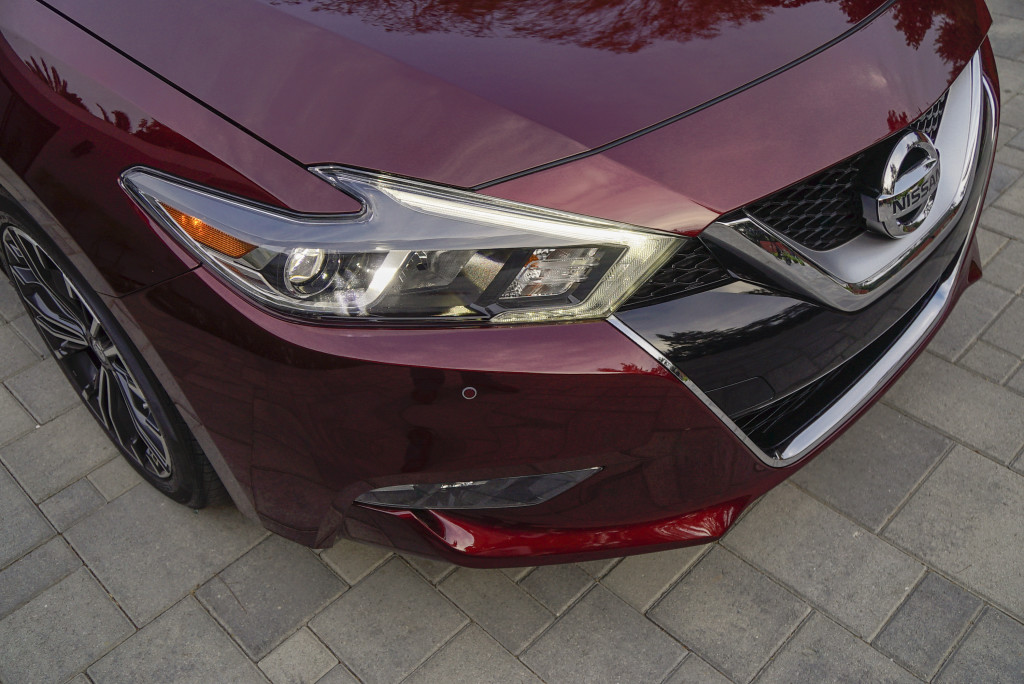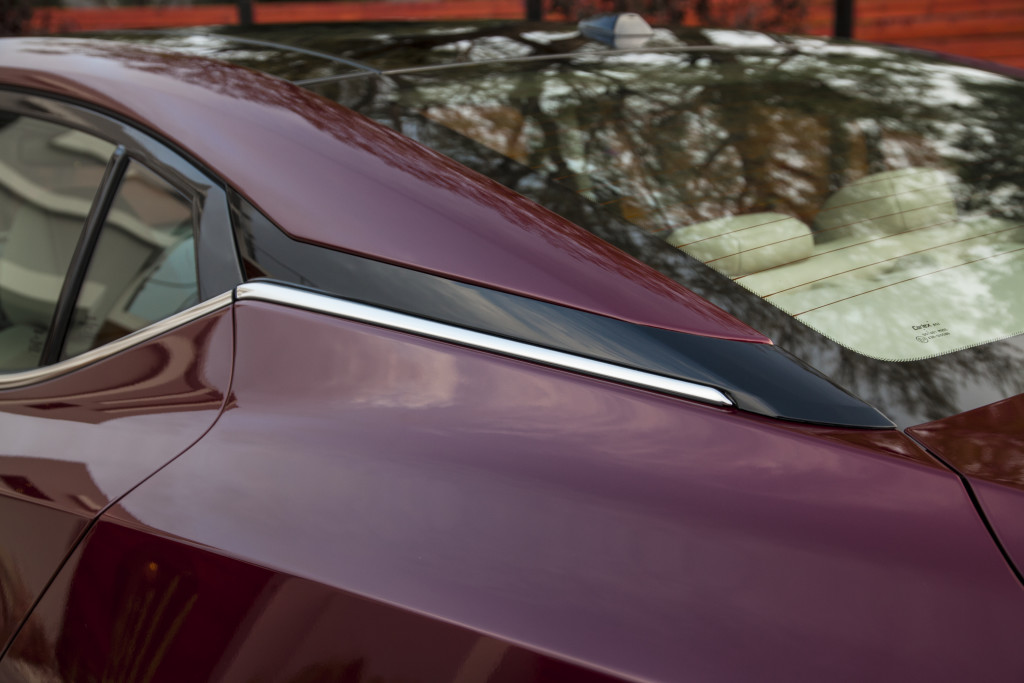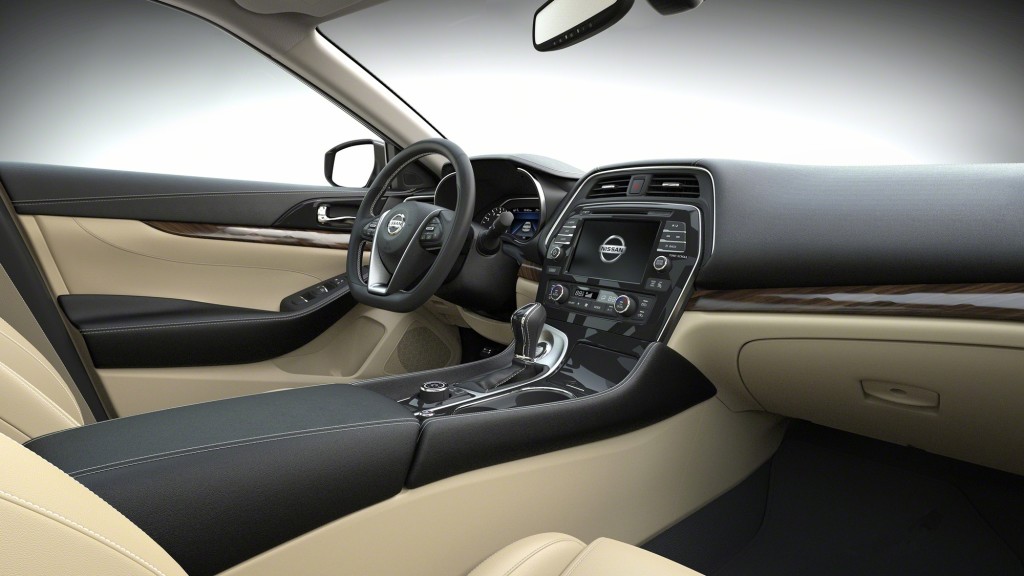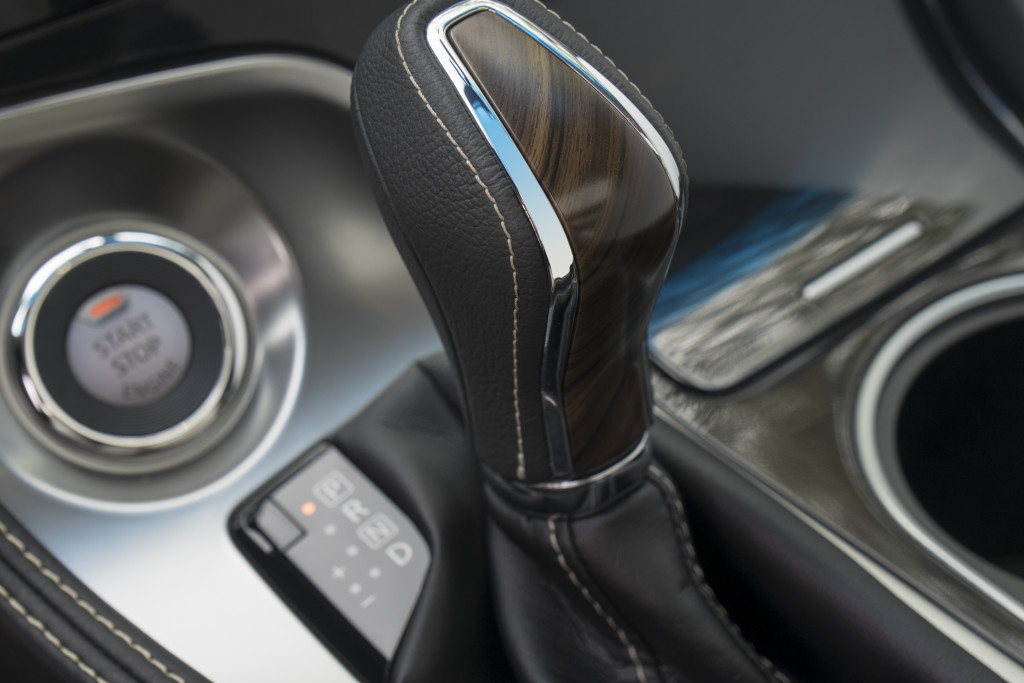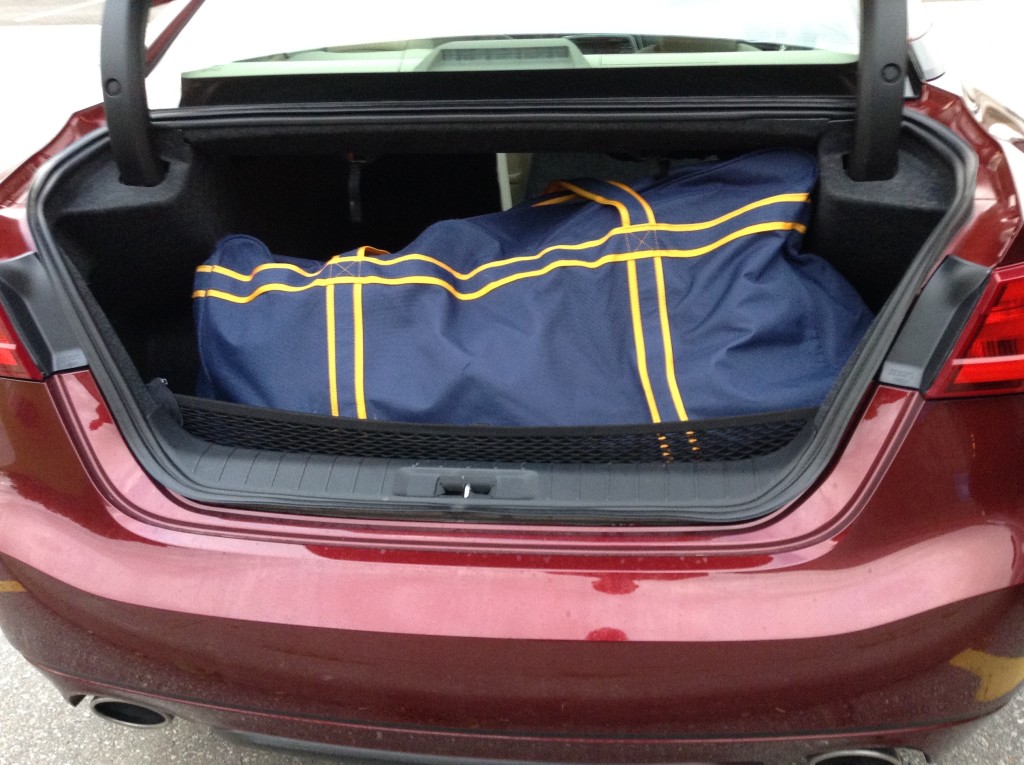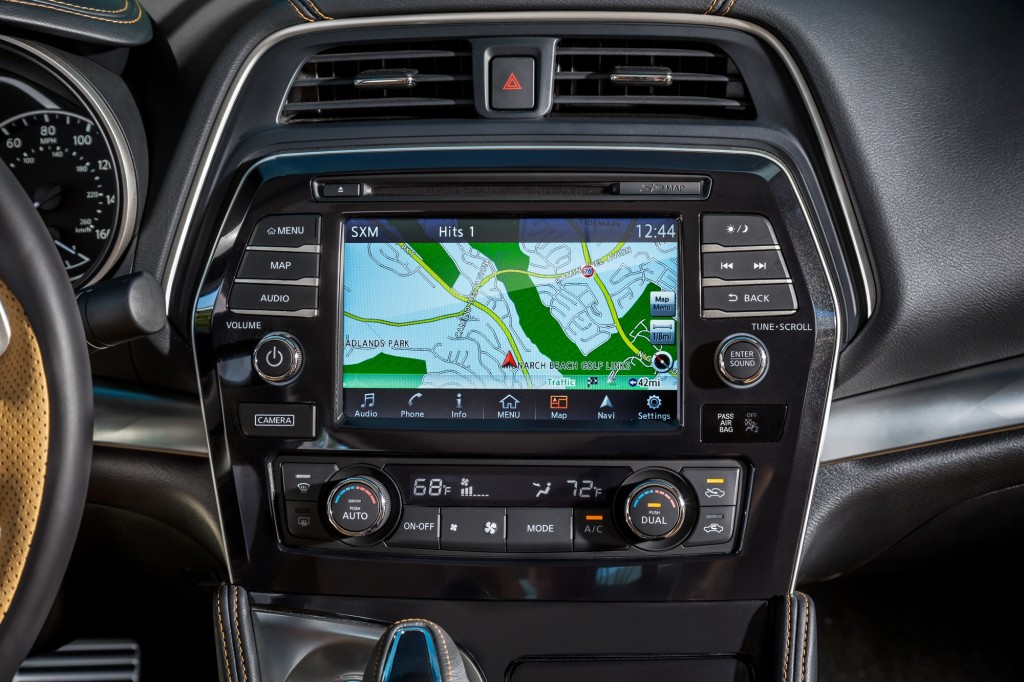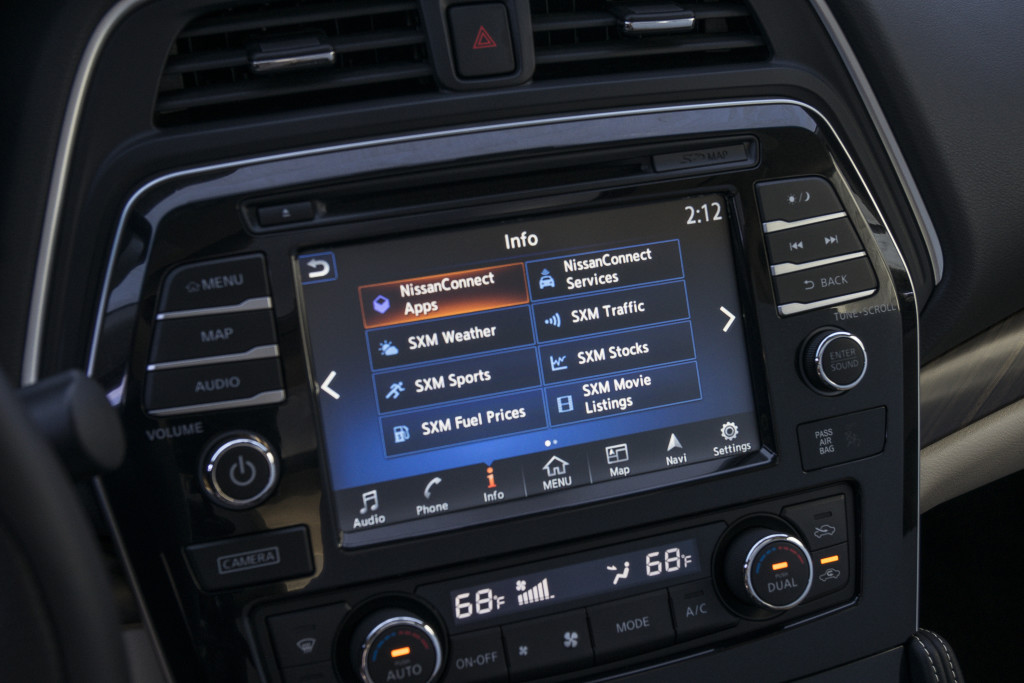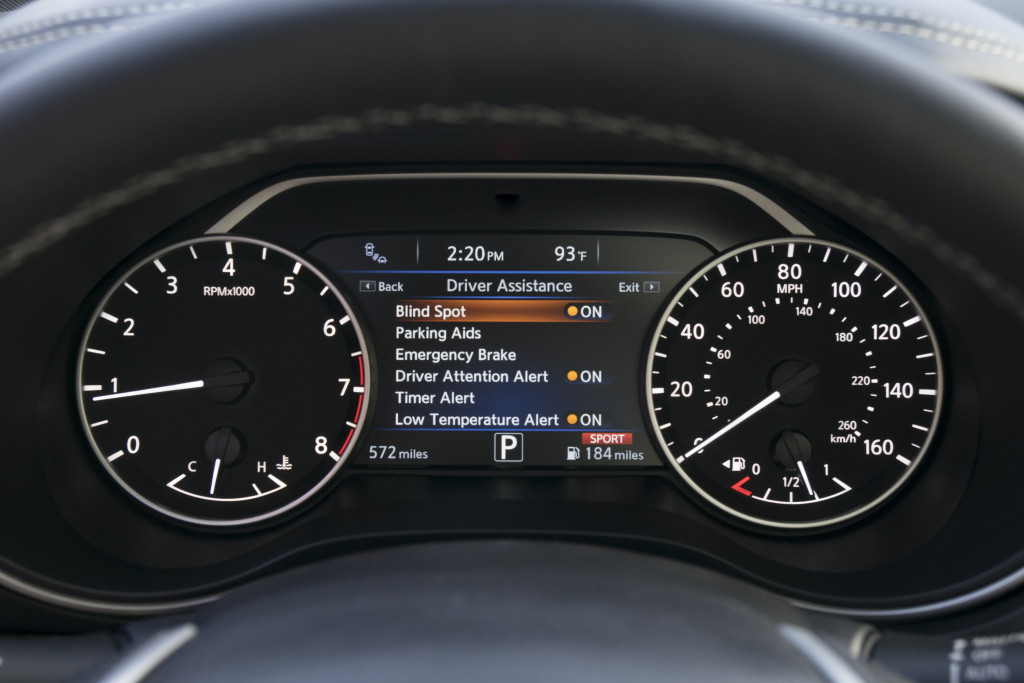When carmakers design new models, they look for inspiration in a variety of places. Nissan’s designers? They visited the U.S. Navy’s Blue Angels. Their attempts to imbue a car with a jet fighter’s looks results in the 2016 Nissan Maxima.
I checked out a Platinum edition in the Maxima-exclusive exterior colour Coulis Red to see what they came up with.
First impressions
The fighter-jet anecdote above contributed to Nissan’s Sport Sedan concept. A muscular hood features an extra convex part towards the centre of the windshield. The hood drops down to curves that rise from a notch at the top of the “boomerang” (Nissan’s term) headlight arrays.
These curves then swoop down to just above half the height of the doors, creating an edgy, scalloped design reminiscent of airflow patterns in wind tunnels.
Just behind the rear door windows, the black material at the top of the window frame joins the chrome at the bottom. The two angle down slightly on their way to the rear window.
Other design changes, from the “V-Motion” front grill to the double tailpipes, add up to a handsome, aggressive sedan stance, with perhaps a hint of fighter jet in it.
Interior
There’s a “wraparound” feel to the cabin that adds some jet appeal to the interior.
Heated and cooled leather front seats welcome passengers, as do (at night) slim ambient lights that stretch from the middle of the front door across the dashboard to the middle of the opposite door. Daylight reveals “mahogany” wood-tone faceted finishers and leather touches around the cabin, much of it accented with fine stitching.
Details like these seat the Maxima firmly in the luxury sedan segment, while sports car touches appear alongside the luxury. The centre stack sits angled seven degrees towards the driver, a design decision lifted from Nissan’s GT-R, while the leather-wrapped steering wheel features a flat bottom.
The driver’s leather seat puts itself into position once the driver starts the car. When the driver opens the door, the seat moves back and the steering wheel goes up a notch to make egress easier. (I enjoyed this convenience when I recently drove the Nissan’s cousin, the Infiniti Q50S Hybrid.) Only the manual thigh extension stays where it is. The Maxima can also remember seat settings for two drivers.
I fit comfortably enough. My head does touch the ceiling, something it would not do if the dual panel panoramic moonroof wasn’t there.
Cargo capacity
The trunk is the size you’d expect in a car named “Maxima.” I could have fit two hockey bags in this trunk without folding down the 60-40 split rear seats. My sticks were a little too long to fit diagonally in the trunk, so one seat did go down.
In-car technology
The 8-inch-touch-screen driven Nissan Connect system offers all the features drivers expect, and then some. Navigation and voice recognition is standard on all trim levels.
The system drives the Platinum’s 11-speaker Bose ® audio system, which also delivers active noise cancellation.
Bluetooth hookup to my iPod Touch worked flawlessly. That said, I can’t use Connect to switch between apps that hold my audio content. I have yet to try an automaker’s proprietary system that properly handles this level of “app complexity.” It shouldn’t be up to carmakers to approve apps that work with in-car infotainment systems. That’s the job of:
- the app developers, who ought to be abel to treat car systems like any other interface (computers, phones, tablets or watches)
- the operating system developers (i.e. Google and Apple) who need to make it possible for app developers to support in-car systems
The Maxima doesn’t have the Q50’s “back button” on the steering wheel. This thoughtful touch comes in handy when you want to navigate on the main touchscreen without touching it, and I’d like to see it on the Maxima too.
Front and rear parking sensors (standard on all 2016 Maximas) beep when you get too near an object. Nissan complements this warning system with its Around-View Monitor, standard only on the Platinum Maxima. (The rear-view camera ships on all 2016 Maximas.) Nissan’s 360-degree camera system appears when you either put the Maxima in reverse or you press the “Camera” button on the centre stack.
Engineers created this view by stitching together images taken from cameras under both side-view mirrors as well as a camera under the “Nissan” badge in the front grill, plus the rearview camera. Parts of the image come through a fisheye lens. The whole image is clearly stitched together from four separate images. While the “fit and finish” might not be ideal, the overall image does enhance driver awareness of immediate surroundings.
Nissan places an image of the Maxima as seen from the top in the middle of a radius that extends several feet from the car at all angles. I’d ask Nissan to add images of the current angles the front wheels, something I found in the Infiniti Q50 I drove a few weeks prior. It’s a small detail, but I liked it.
The 7” Advanced Drive-Assist display in the instrument cluster shows a variety of automotive readouts and settings. You’ll find tire pressure numbers, current fuel economy, settings for proximity sensors and the settings for each of these features. Nissan does a great job putting the controls for this screen under the driver’s left thumb.
A media bin just ahead of the shift knob contains two USB ports and enough room to hold two large devices as they charge. How large? iPhone 6 Plus large. The media bin’s door helpfully conceals all this from prying eyes.
Driving
Nissan’s 3.5-litre V6 engine puts out 300 horsepower at 6,400 RPM and 261 punds-feet of torque at 4,400 RPM. These numbers translate into smooth, quite highway driving plus the oomph to pass whenever you please. City driving proved just as refined.
Nissan’s new Xtronic transmission (a continuously variable model) keeps the engine running as fuel-efficiently as possible while responding instantly to any blip of the accelerator.
The Drive Mode Selector (Sport and Normal modes) adjusts throttle response, transmission tuning, steering feel and Active Sound Enhancement tuning. The latter feature amplifies the “engine note” you hear in the cabin (something fighter jet pilots probably wouldn’t miss). It’s an increasingly common add-on in cars that seem to have become too quiet for some drivers.
Vented disc brakes at all four wheels get their smarts from both brake assist and electronic brake force distribution for sure-footed stops.
Fuel economy
As you might expect, you won’t go below 10 litres/100 kilometres in city driving. This engine shines during highway cruises, not even approaching 2,000 RPM as it sips fuel sparingly from its 68-litre tank.
Nissan’s numbers are
- 10.9 litres/100km in the city,
- 7.8 on the highway
- 9.5 combined
Safety features
The Maxima ships with a wide array of safety technology, from air bags all over the cabin to child safety features to technology enhancements like blind spot warnings, rear cross traffic alerts, forward emergency braking and predictive forward collision warning. (Not all advanced technologies ships on all models.)
Pricing
The Platinum model I drove starts at $43,300 MSRP. The entry-level SV starts at$35,900 MSRP. The lineup also includes two middle children: SL and SR.
Conclusion
A jet fighter that can charge and hide your phablet at the same time? Maybe not, but the 2016 Maxima will carry drivers (and their phones) in a fine combination of power, comfort and style.

